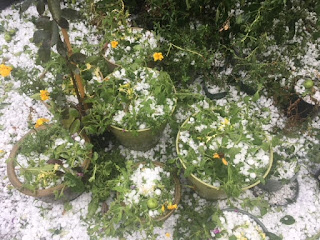If you live along the Front Range in Colorado and have not had your yard ravaged by hail this year, you should count yourself lucky! I've been in the vicinity of four hailstorms around Weld and Larimer counties this year...and that's four too many! Hail can wreak havoc on one's landscape and garden. After hail, you might be wondering if your garden is toast or if there is something you can do to save the landscape. Depending on the time of year and the severity of the storm, there may be hope...
Hail forms within strong updrafts of some thunderstorms. As the air in the storm rises, it cools due to drops in pressure and temperature creating a colder air mass at the top of the storm. Ice particles can move upward due to the updraft and collect water as they rise, causing them to grow in size. The newly formed hail stones will swirl around in the upper layers of the storm. However, eventually the storm cannot hold onto the heavy hailstone, gravity takes over and it falls to the ground.
 |
| https://climate.ncsu.edu/edu/SevereHazards |
The organization Community Collaborative Rain, Hail & Snow Network (CoCoRaHS for short) has a list of hail facts on their website along with a ton of other great weather information. Here are a few interesting facts about Colorado's affinity for these falling ice balls (you can find the complete list here):
- Colorado is one of the most hail-prone states in the U.S.
- The Colorado hail season is April 15 to September 15.
- Hail occurs more frequently in the lee of the Rockies than anywhere else in North America.
- Hail also occurs very frequently in the high Colorado mountains during the summer. These stones, however, tend to be small and soft and rarely do damage.
 |
| Check hail reports for your county here. |
So what should you do if your garden or landscape gets hit by hail? Your trees will show the most damage toward the tops as this is where it takes the most beating. Any leaf area still on the tree will continue to photosynthesize and will likely keep the tree going through the rest of the growing season. The tree should leaf out okay the following year. if the damage was not too great. However, keep in mind that the hail can also do damage to the branches and open up the tree to disease, so hail damaged trees should be monitored for additional stress throughout the season. Similar monitoring should be done with perennials, as well.
 |
| The Weld County Extension Demonstration Garden after the June19th hail storm, up to dime-size hail. |
 |
| The Weld County Extension Demonstration Garden 1 month after the hail storm, recovering nicely. |
Depending on the time of year that hail hits your annual flowers, they might have enough time to recover and look nice. In early June, I had several containers of annuals damaged by a severe hail storm (up to quarter sized hail for an extended period of time). Needless to say the plants were shredded, with just a few leaf pieces hanging on for dear life. Upon further inspection, I noticed that there were a few new growth points that looked to be spared. So I waited. It's a good idea to wait a few days (up to a week or so) after hail has damaged you plants before you prune them back. This way you can see where there is hope for regrowth, allowing you to leave that growth on the plant when pruning off dead plant parts.
 |
| Quarter-size hail from the June 19th near north Fort Collins. |
 |
| My lovely containers of petunias, zinnias and coleus after hail on June 19th. |
 |
| Even though this coleus was shredded, a few growing points are still in tact. |
After about a week, I removed the dead portions from these annuals and made sure to keep them well watered and as stress-free as possible over the next month to help them recover. After about 5 weeks, the annuals are recovering well.
 |
| Five weeks after hail damage. If you look close, you can see that the coleus from the last picture is growing again. |
Vegetables are tricky, as some will not recover at all after a hail storm, while others might be salvageable. Give it a week and see how they respond. You may need to replant if it's early enough in the season. Row covers and hoop houses can be helpful, along with hard structures to protect the plants. The University of Wyoming has an article with additional tips on how to protect the vegetable garden from hail. That article can be found here.
So don't loose all hope! If it's early enough in the season to get regrowth and if the severity of the hail left some leaf tissue in tact, the plants may be able to recover with time and a little TLC.
Click here to find more information on how to deal with hail damage in this Planttalk Colorado™ article regarding hail.

No comments:
Post a Comment